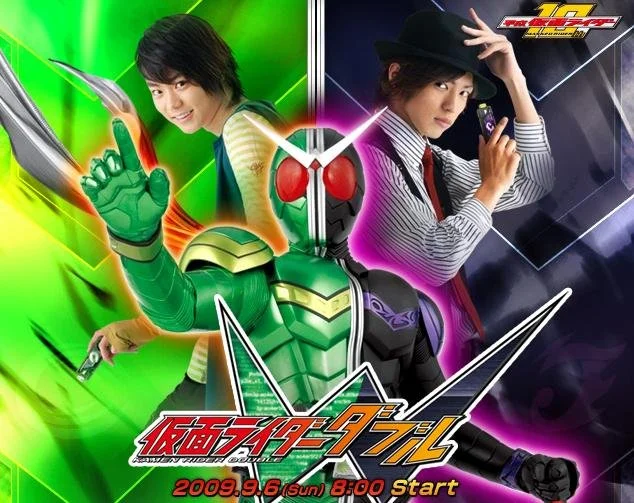Henshin to Life: The “Real,” the “Cartoonish,” and the Impossibilities of Animated Tokusatsu with Kamen Rider W and Fuuto PI
Tokusatsu is a Japanese media genre that translates roughly to “special effects,” hallmarked by its use of suits and over-the-top action scenes in a live action production. Think Godzilla and Ultraman, or Power Rangers for readers around my age. The reason I find myself interested in tokusatsu is that over-the-top spectacle. There’s not a lot that hits for me much better than a guy in a well-designed suit performing a flashy kick into a gross rubber monster suit accompanied by a huge explosion.
One of tokusatsu’s little anomalies is the Kamen Rider franchise, verifiably huge in Japan but with a light presence in other countries, contrasting the three previous examples. Though its origins lie in the year 1971, Kamen Rider has been an episodic Sunday morning TV show that drastically changes its cast, premise, and visuals every year with a new series since 2000. The Sunday morning timeslot is important, as Sunday is the day Japanese schools have off. Think of the timeslot like Saturday morning cartoons in the West.
The 2009/10 season, Kamen Rider W, is a detective-type programme where the titular hero (to be called W from here on) is comprised of amateur sleuth Shotaro Hidari and the mysterious Philip (no last name) (Fig. 1). The pair transform into W using USB-shaped toys called Gaia Memories and a specialized belt called the Doubledriver. A belt that allows its wearer to transform is a staple of Kamen Rider, and roleplay toys of the belts are the main products the show advertises to its young viewers. As W, the pair fight off monsters called Dopants and solve crimes across two consecutive weekly episodes per case.
This isn’t the Fantasy/Tokusatsu blog, of course. Come 2022, Kamen Rider W received an animated adaptation and continuation called Fuuto PI. Fuuto PI maintains a similar construction to Kamen Rider W, simply adding a woman named Tokime to the core cast and stretching the mysteries over three episodes instead of two. I watched Fuuto PI immediately after finishing Kamen Rider W, and couldn’t shake one specific thought from my head about the anime.
“This is just better.”
Why? Tokusatsu, especially Kamen Rider, mostly stays in the realm of live action. The unfamiliarity of the franchise to animation might suggest it would be worse off. But instead, the spectacle in Fuuto PI simply blew the original Kamen Rider W out of the water. To demonstrate how, I’ll compare and contrast key scenes to both shows with a little bit of scholarship to assist me.
In her piece “Kamen Rider: A Monstrous Hero,” Sophia Staite mentions the importance of transformation scenes in such shows, going so far as to say that merchandise sales are “vital.” Since the belts are the catalysts to transformation and are the main product being advertised to the young viewers, the first usage of them needs to be highlighted to seem attractive to viewers. She quotes Anne Allison’s concept of the “money shot” for these kinds of scenes, being scenes that the young viewers look forward to and are excited for. I would like to add that there is another type of “money shot” that Kamen Rider likes to use: the finisher. By fiddling with the Doubledriver, W can perform a flashy finishing attack that is sure to defeat the monster. This not only showcases the Doubledriver’s functionality to viewers, but also grants an iconic pose to the character that can be recreated in action figures.
With the background information in play, let’s move on to the transformation scene.
W First Henshin.
Kamen Rider W’s first transformation scene needs to set up the mechanisms of how the transformation works, as it is new territory for viewers. Despite the scene lasting for over a minute, the actual transformation takes only three seconds, and is visually represented by gray pieces quickly flying onto Shotaro until W stands where he was. The remainder of the scene is about dramatizing the transformation process and showing how the unique transformation of two people into one hero works. The spectacle is marred by both the explanation and by noticeable camera tricks to make the explanation work, like Philip’s Gaia Memory appearing in Shotaro’s Doubledriver. The scene simply flashes white and the camera angle shifts slightly, making it clear that the effect was achieved by simply recording a separate shot with the Gaia Memory in the belt. This lack of fluidity may not be immediately distracting to a viewer, but Fuuto PI will prove how much better this idea can be realized in animation.
Fuuto PI First Henshin.
Fuuto PI, due to its animated medium, needn’t be concerned with the tricks needed to pull off a convincing illusion like Kamen Rider W. It can simply animate them. While Fuuto PI presumes the viewer is familiar enough with Kamen Rider W and thus skips much of the preamble about how the transformation works, the scene lasts just under a minute, not much shorter than the original scene. There remain many similarities, like the poses Shotaro and Philip take and the franchise mainstay call of “henshin,” meaning “transform.” However, significantly more time is given to the actual transformation. Instead of a few nondescript gray shapes flying onto Shotaro, the suit seems to be constructed onto him. There are flashier and more colorful effects to accompany the change. Since Fuuto PI was released over a decade after the original Kamen Rider W and does not share its Sunday morning timeslot, it is not as concerned with peddling Doubledrivers. It instead seeks to make W himself (themselves?) look better.
I believe that placing the focus on the hero instead of his belt in a franchise known for selling toys turns the merchandizing focus to memorabilia of the hero, such as action figures. It is not surprising that publisher Bandai Namco timed the release of a reissue of their W S.H. Figuarts action figure to match the original airing of the anime in August 2022. These action figures can be used to recreate what I consider to be the other important “money shot,” the finisher.
W Finisher.
In Kamen Rider W, the first finisher lasts less than twenty seconds. It involves W floating up into the air via a gust of wind, splitting into two halves, and kicking the monster. There’s space to argue that the splitting is a spectacle in and of itself, as no Kamen Rider before or since has bisected himself during an attack. It even ties into the W Form Change action figure line that was released with the show, as the figures are capable of splitting in the same way. However, the splitting itself is incredibly awkward visually. W just sort of drags across the screen and splits before hanging in the air as each half hits the monster separately. The background music is an unexciting loop. Compare this to Fuuto PI.
Fuuto PI Finisher.
Fuuto PI’s first finisher takes just under forty seconds, over double Kamen Rider W’s time. When W floats up for the attack, he is enveloped by a green tornado. The shot gives a lot of attention to W splitting, and since there is no need to combine special effects and live action, the split ends up absolutely seamless.
Fuuto PI is a rare show in tokusatsu for being animated. Though animation is gaining traction in the tokusatsu sphere with recent releases such as Ultraman Rising (2024) and Godzilla Singular Point (2021), it is by no means the dominant mode. Though anyone can claim anything about if live action or animation is better, I would argue that Fuuto PI is adept at doing what Kamen Rider W sought to do over fifteen years ago.
**Article published: May 23, 2025**
References
Allison, Anne. 2006. Millennial Monsters: Japanese Toys and the Global Imagination. Berkeley: University of California Press.
Staite, Sophia. 2021. “Kamen Rider: A Monstrous Hero.” M/C Journal 24, no. 5 (October), available at: https://journal.media-culture.org.au/index.php/mcjournal/article/view/2834.
Biography
Andrew Barrow is a film studies graduate student at the University of South Florida’s Tampa campus, coming off of a bachelor’s degree in English from the University of North Florida in Jacksonville. He got deep into Kamen Rider in 2020, and still isn’t sure if that was less damaging than catching COVID-19 would have been. You can find him spouting opinions about Kamen Rider and saccharine sweet romances on Letterboxd under the name ClockUp.

